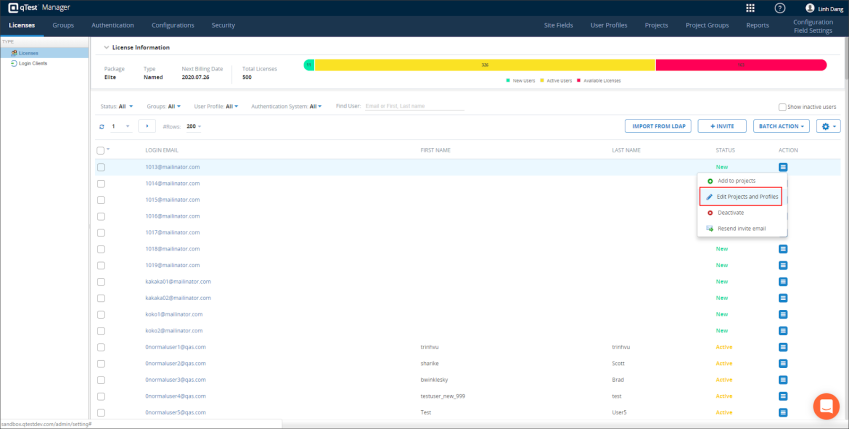Batch Actions
Batch Actions allow Administrators to manage and modify potentially large groups of users simultaneously. You will find the Batch Action icon on the License Information page.
Batch Actions include:
-
Assign projects
-
Reset Passwords
Resetting a user's password will reset all of that user's tokens. -
Export Users
-
Update Users
-
Activate Users
-
Deactivate Users
-
Resend Invite Emails
Why use Batch Actions?
Some Administrators may be in charge of very large numbers of users and having to act upon each of these users one by one can become very costly. Batch Actions can vastly cut down the time administrators spend when modifying users and their information in qTest.
Prerequisites
Users will need to be a Site Administrator in order to be able to access the Administration features and use Batch Actions.
How to get here
Site Administrator that want to assign multiple users to multiple projects using the Batch Action feature, should follow these steps:
-
In qTest Manager, select Administration from the username drop-down menu.
-
The Licenses tab page displays. Here, select the check boxes associated with the users whom you want to be added to your projects.
-
Select the Batch Action icon. From the drop-down menu, select Assign to Projects.
-
The Add Users to Projects dialog displays. Select the Projects from the menu on the left, and then select the right arrow.
-
Select Save.Your selected users have now been added to the selected projects.
Bulk edit user profiles: use case
Site Administrators can also bulk edit User Profiles for one user across multiple projects. This is helpful for adding a user to multiple Projects, while also managing their User Profiles (which might vary based on the Project.)
For this example, you would use Edit Projects and Profiles:
- Allows you to update the user's User Profile on a per Project basis.
-
This can also be used for adding a user to other projects.

User authentication: use case
Site Administrators can batch manage User Authentication.The following actions can be performed in batches:
-
The system now supports admin importation of user info from an .xls file. Here, an admin can change auth system information.
-
All imported Excel files will be scanned for malware and viruses.
-
-
Admins can now save the external username of an internal user. That way, the admin can reuse these usernames if there is a switch from LDAP to SSO authentication. Previously, these external usernames were not imported when changing the authentication system, and if changing back, the admin had to re-enter external usernames.
-
Users are automatically activated when an admin changes their authentication system from Internal to LDAP/SSO using the import tool.
Update users (import) batch action
The Batch Action associated with updating user information allows site administrators to export an Excel file from qTest. Users can then modify the Excel file and re-import the file into qTest. qTest will read the file and can update the following user information accordingly:
-
Email
-
First Name
-
Last Name
-
Auth system
-
SSO username
-
LDAP username
Admins can also check logs for exact error reports for each user. These logs can be exported into Excel, modified, and then re-imported back into qTest Manager to send an invitation with the correct information.
Example
When changing the authentication system from LDAP to SSO, in most cases, SSO usernames will be the same as LDAP usernames. The site admin may want to export users with LDAP usernames first and then re-use the LDAP usernames as SSO usernames.
In qTest, enabling SSO will automatically disable LDAP, and all LDAP usernames are cleared out. In this case, the Site Admin should export users BEFORE disabling LDAP or enabling SSO .